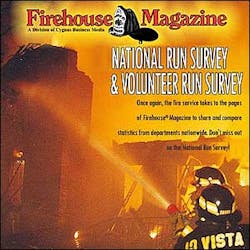National Run Survey: Busiest Ladder Companies of 2006
For the 26th year, the career fire service takes to the pages of Firehouse Magazine to share and compare statistics about company and department activity levels, funding, staffing and pay. A total of 244 fire departments took part in this year's survey, representing 45 states, the District of Columbia and 8 Canadian provinces.
The departments represented in this latest survey protect 79,994,388 people, and they have budgets totaling more than $12 billion. They provide this service with 4,095 engine companies, 1,489 ladder companies, 1,826 ambulances and numerous other specialized units.
They respond to 1,623,691 fire calls, 7,284,434 EMS calls and 10,757,152 total calls last year.
Here are profiles on the busiest departments in the United States and Canada as listed in the July issue of Firehouse Magazine:
Busiest Ladder Company (United States)
New York City's Ladder 26 was the busiest ladder company in the United States in 2006, responding to 4,356 calls, according to Firehouse Magazine's National Run Survey.
Boston's Ladder 26 was second on the list with 3,934 reported calls followed by Baltimore City's Truck 1 with 3,774 reported calls.
The FDNY as a whole serves a city of more than 8 million people. For 2006, FDNY led all departments in the U.S. with 1,439,616 reported calls.
Ladder 26 is one of 143 ladder companies in the city and is located in Manhattan and covers a large area that includes the south end of Harlem.
According to Firefighter Jim Long, a spokesman for the FDNY, the number of runs each company compiles varies throughout the city. Most companies fall in the 3,200 to 3,600 range while bigger companies compile 3,600 to 4,000 runs. He said there are even small companies that have less than 3,000 runs.
"It really depends on the area you are serving," he said. "There are many other busy companies in the city but this year that one happened to be the busiest."
Long said firefighters work a two-day tour from 9 a.m. to 6 p.m. or 6 p.m. to 9 a.m. and are generally off for 48 hours. Firefighters also permitted to work 24 hour periods as part of mutual aid.
"Depending on the calls they are going on or the calls they're dispatched to there always is a required recuperation time," he said.
Long said that he doesn't know what the rate of firefighters from other companies requesting transfers to Ladder 26, but said that he wouldn't be surprised if it was near the top of their lists.
"It's a company with great pride and traditions and it would be considered desired company to work in, he said."
Busiest Ladder Company (Canada)
Winnipeg's Ladder 1 was the busiest on the other side of the border, responding to 2,787 calls last year, according to Firehouse Magazine's National Run Survey.
Ladder 1, an E-1 aerial platform, is located in the city's main station downtown where there are 22 people per shift.
Those personnel in the city's core staff eight units.
Records show Edmonton's Ladder 5 came in second with 2,526 responses.
Winnipeg's firefighters and paramedics operate out of 26 stations to provide services to the residents and visitors in the largest city in the province. There also are three stand-alone EMS companies.
The department is responsible for all emergencies -- firefighting, rescues and EMS. The communications center also is staffed by trained personnel who offer pre-arrival patient care instructions, said Deputy Chief Ken Sim.
The city also doesn't ask for outside help. They don't have a mutual aid agreement that would bring assistance from anyone across the line. However, on occasion, they go beyond the boundary if requested.
They also respond to incidents that could impact the city and its resources.
Sim said the departments on the outskirts of Winnipeg are volunteer, and the majority don't have equipment that would be of any use. However, he said as those companies enhance their fleets, that could change.
While there is no water supply issue, narrow streets often provide quite a challenge as fire equipment traverses through the city. "In the core (downtown), there's a lot of old stock (buildings). We're often referred to as the 'Chicago of the North.' So, there's a lot of potential for serious fire loss..."
He said the department suffered a tremendous loss in February when two captains were killed in a flashover. Several others were hurt in the same incident.
People considered for employment must already hold firefighter and paramedic credentials. Once hired, they attend a five-week orientation at the Winnipeg training academy to familiarize them with procedures and SOPs
Requiring that training is making recruitment more and more challenging," Sim admitted, adding that the department was faced with 40 retirements in the past year. Filling those slots wasn't easy.
The training facility includes a tower and burn building. They got away from conducting their own 18-week academy years ago.
Winnipeg has three boats, and specially trained personnel to handle water rescues.
They also have technical rescue technicians as well as firefighters with Hazmat training. "Winnipeg has a large rail hub and level 4 research lab. So, we have to be ready..."
The department also has two fully-equipped hazmat units.
There are six rescue companies, and those personnel are dispatched to staff the ladders. "They get their tasks on the scene."
The crews work two 10-hour day shifts (6 a.m. to 8 p.m.), followed by two night shifts (8 p.m. to 6 a.m.). Then, they have four days off. Sim said personnel are very happy with the configuration because it gives them so much freedom for other activities.
"We switched to it in the '60s, and they like it because they can have a business on the side ..."
